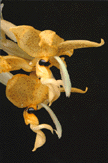
Native to Peru
Edited 29 June 2007

Original publication: Bulletin of Miscellaneous Information, Royal Gardens, Kew [Bull. Misc. Inform. Kew]: p.364.
Oddly, this species is not included in Charles Schweinfurth's 1960 publication, Orchids of Peru, published in Fieldiana: Botany. That treatise lists only eight stanhopea species, one of which (Stan. Randii) is no longer considered valid (now Stan. candida). The orchids of Peru are currently being reconsidered by Calaway H. Dodson and David E. Bennett Jr. in the Orchids of Peru: Icones Plantarum Tropicarum, Series II [1991], published by the Missouri Botanical Garden. David E. Bennett also collaborated with Eric A. Christenson in producing the
Icones Orchidacearum Peruviarum, in which Stanhopea nigripes is presented as plate 577.
Photos at left and right taken of a plant blooming in Houston, Texas, Nov 2001. Flowers solid orange except for the winged column, which is translucent, pale greenish-cream with faint red stipples. The outside of the sepals also has faint red stipples. Unscented; overall flower size 7 x 8 cm.
Roque and Leon (2006) list this endemic Peruvian species as being found in the Departments of Amazonas, Huánuco, and Pasco, at 800-1900 m elevation.
Distinguishing features are the dark red blotches on the hypochile, the blunt-tipped, recurved epichile, and the distinct ridges, or furrows, on the top of the mesochile, along with stubby horns. The plant has small bulbs and leaves, definitely no larger than a walnut, and it's a first-bloom seedling.
.
.

Stanhopea nigripes 'Linda' CHM/AOS
Seven flowers and one bud on one inflorescence; floral segments uniformly bright sulfur yellow finely speckled with maroon (peppering on lip finer than that on sepals and petals); lip with large maroon band at base; column white, wings minutely spotted with maroon; flowers well-displayed on inflorescense; sepals large and full, with petals smaller, recurved, and with attractive ruffled edges; pleasant concentrated fragrance.
Measurements: Nat. spread 9.3cm horiz, 9.7cm vert; Petals 1.5cm wide, 4.5cm long; dorsal sepal 3.0cm wide, 5.0cm long; lateral sepals 3.7cm wide, 4.7cm long; lip 2.7cm wide, 5.0cm long.
Awarded at Northeast Regional Monthly Judging, New York, NY, 17 Oct. 1984.
Exhibitors: Gary & Linda Kraus, West Boxford, MA;
Photo at left copyright Charles Marden Fitch

The Baker's culture sheet indicates that Stanhopea nigripes has been found in Peru in the Department of Huanuco between Tingo Maria and Opuculpa at 3600 ft. (1100 m). They say that the rainfall is heavy all year, and the plant should be kept in "growing conditions" year-round. In the habitat, throughout the year, days average 80-83F (27-28C), and nights average 58-61F (14-16C), with a diurnal range of 19-24F (11-13C).
Their culture sheets (some free, some a buck) can be found at:
http://www.orchidculture.com/
You can select and receive any 2 of the non-free sheets and look at them, and if you don't like them you don't have to pay.
"In my experience, it's not a "large" Stanhopea, meaning the leaves are only a foot long or so. Nice flowers, several per spike. I grow it in a shallow (3"), basket filled with fast draining ceramic pellets, but water it daily. If you used a medium that retained water more water, or a deeper basket, daily water would probably not be required. Deep baskets may not be good though, because spikes often grow downward through the medium and won't make it if they have to go too far."
- ->Troy Meyers,
Meyers Conservatory, Poulsbo, Washington.
Printed References:
David E. Bennett and Eric A. Christenson (1993?) Icones Orchidacearum Peruviarum, [Stanhopea nigripes, plate 577].
Robert Allen Rolfe (1894) in: Bulletin of Miscellaneous Information, Royal Gardens, Kew [Bull. Misc. Inform. Kew]: p. 364.
José Roque and Blanca León (December 2006) "Orchidaceae endemicas del Perú," in: Rev. Peru. Biol., 13(2): 759s-878s. Link:
http://sisbib.unmsm.edu.pe/BVRevistas/biologia/v13n2/pdf/a145.pdf.
[Stanhopea deltoidea, greeri, haseloviana, manriquei, marizaiana, moliana, naurayi, nigripes, peruviana]
Online References:
International Plant Names Index [IPNI],
www.ipni.org.
Photo, Dutch collection of Jitze Mud (Dutch); try this page for
English, and click here for a closeup.